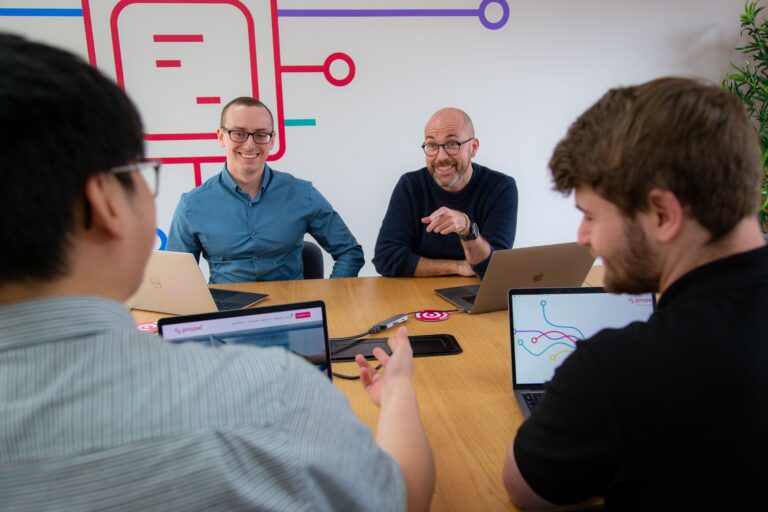When there is a workplace challenge to solve the go-to business process to identify new ideas for growth and improvement opportunities is based around people sitting in a room brainstorming. However, decades of research have consistently proven this to be ineffective when compared to alternate thinking techniques.
Given the economic, social, and environmental challenges being faced by businesses as HR professionals you’ll know that we need fresh thinking that delivers new and practical solutions to these challenges. Organizations are facing new and difficult questions they need to answer—or they may just need superior answers to old questions. Whatever the issue, the best solutions always seem blindingly obvious in hindsight—yet they remain tantalisingly elusive to identify when needed.
The Freaky Thinking process is designed to go beyond the realms of conventional wisdom and to explore for, and identify, pragmatic new ideas which form the valuable solutions needed. It’s the first radically different approach to workplace thinking in the last 70 years. Here are some steps to share with your HR team, and more widely in your organisation, so that individuals can start putting this into practice.
Doing your best thinking
The best place to begin is by looking at when you do your best thinking. What are you doing when you get your best ideas? Taking a shower? Walking the dog? Driving? Exercising at the gym? I’ve asked this question of thousands of people and these are the answers I most-frequently get. They generally tend to be activities where we’re alone with our thoughts.
What’s also extraordinary is that people rarely say they get their best ideas at work. This finding is consistent across all levels of an organization and often surprises leadership. While organizations may encourage employees to ‘bring their full selves’ to work—they may not be applying their minds as well as they could be.
The science
Research from the University of California, Santa Barbara in 2012 helped shed light on why we tend to get our best ideas when doing a simple task of some kind. Participants were given two creative thinking tests with different actions to perform between the tests. The group that showed the greatest improvement (of over 40%) was that where the participants were given an ‘undemanding task’ to do. They fared much better than those who performed a demanding task or who were told to sit and relax in the short break between the tests.
The summary of the research? We’re more effective thinkers while we’re performing an undemanding task—like walking, driving or exercising.
Pose Killer Questions to find the purpose for our thinking
In order to come up with great solutions and ideas, you need to ask the right ‘killer questions’. A question, by definition, needs to be resolved by an answer. Questions and answers go together just as left and right are two sides to an item. And the ideas you come up with are actually the answers to questions—either to a question that you’ve posed for yourself, or to a question that someone else has asked you.
We’d all like the ideas we come up with to be bold and powerful, such that they impress those around us. But if ideas are the answers to questions, then to get bold and powerful answers, we need to be posing bold and powerful questions that stimulate this type of answer. In Freaky Thinking this type of question is called a Killer Question.
A Killer Question is one that, when answered well, will deliver significant value for you. It’s a question that you—or the organization—haven’t yet been able to answer satisfactorily, and it’s one you intuitively feel is possible to answer. It’s a question that has many potential answers and where you’ll have to choose the best one to execute. Just because you couldn’t answer a specific work question previously, doesn’t mean it’s impossible to answer. It just means that your thinking wasn’t imaginative enough to answer it then. But with a Freaky Thinking approach that positions it as a Killer Question, you can potentially answer it now.
A Killer Question ignites a fire, or a passion, for you personally. It’s when you recognise that if you are able to answer it well, there will be significant benefit for your organization, your team, or yourself. Killer Questions spark genuine personal interest in finding great answers to them—and ignite an individual’s curiosity.
Encourage curiosity
On 8th June 1991, Kathy Betts, a part-time clerical worker processing medical claims for the Massachusetts State Government made the front page of the New York Times newspaper. She’d posed—and answered—a Killer Question that had helped the state of Massachusetts re-classify certain types of claims such that they could claim additional funding from the Federal Government.
At the time, Kathy Betts was 38-years old and had been employed by the state government for 12 years. She’d recently reduced her hours down to three days a week to spend more time with her two children. Because of what she knew about her work, Kathy Betts felt sure that there was some way the state could claim greater match-funding for the expenses it incurred when it refunded individual hospitals. She took home manuals and guidelines to study, searching for ways to answer her question—and over time her curiosity helped her to find the answer. Her idea enabled the state to receive additional funding over a six-year period which exceeded USD 1.4 billion (GBP 2.4 billion converted to today’s money).
She later stated that no-one else knew the combination of things she did about her role—which helped her find new answers to her Killer Question. But doesn’t this apply to every employee in every business? Nobody else knows the same combination of things as anybody else—which offers anyone the opportunity to think like Kathy Betts. And to deliver equivalent levels of value for their employer?
Here are two more recently reported examples of individuals posing Killer Questions of themselves that initiated their curiosity to produce unexpected results:
- BBC News 5/1/2023: Londoner solves 20,000-year Ice Age drawings mystery https://www.bbc.co.uk/news/uk-england-london-64162799
- An AI programmer cracks a pure maths problem https://www.quantamagazine.org/long-out-of-math-an-ai-programmer-cracks-a-pure-math-problem-20230103?ref=refind
So, what are you or members of your team curious about? What problems do you/they encounter regularly in your workplace? What problem do you keep coming back to with that intuitive sense that there must be a solution, if you could just grasp it? Each team member probably has a different ‘curious problem’ so tap into their individual curiosity. This a great place to start.
Motivating great thinking
There are elements of our work that we must do to stay employed. These elements form the basis of our daily activities and it’s the reason we get paid by our organization. If you chose the job you’re in, then you accepted that these tasks would occupy the bulk of your time. These tasks are motivated externally by your need for a salary—and, by extension, the need to keep your job.
Intrinsic motivation is where you’re motivated by what makes you feel good, and what you enjoy doing. Deciding to learn a new skill, like a language, because you want to, and not because you need to, is intrinsic motivation. The litmus test may be whether you have been told to do something, or whether you’re self-starting a task because you want to do something.
In The Art of Impossible: A Peak Performance Primer, author Steven Kotler has combined neuroscience with decades of research to create a guide for extreme performance improvement. He writes that our big five intrinsic motivators are: curiosity; passion; purpose; autonomy; and mastery.
Killer Questions are an integration of an individual’s curiosity, passion and purpose. Allowing them the freedom to do their thinking in their own best personal place and time is the autonomy. And the excitement of incremental improvements as they sense new solutions being identified is their sense of mastery.
So, follow your curiosity, and encourage your team to do the same. Make time to ‘pull on that thread’ without the stress of looming deadlines. Make space for people to follow what appeals to them and find solutions to the problems that interest them.
Encourage people to use Freaky Thinking to explore for insightful answers and opportunities when they are in their own most-creative places. Away from the work environment. Later, when they have identified some interesting ideas on their own, they can share these with others to assess and develop them into ideal solutions.
There is a solution to almost every business challenge, we just need to change the way we approach thinking about these challenges and allow our teams some ‘freaky thinking’ space.









